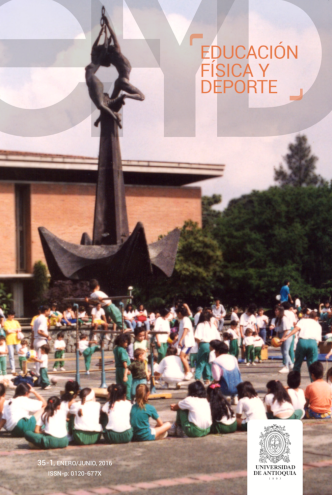Hematologic response to a Crossfit®-based high-intensity interval training (hit) session
DOI:
https://doi.org/10.17533/udea.efyd.v35n1a02Keywords:
exercise, resistance training, hematocrit, leukocytesAbstract
Aim: To evaluate the hematologic response to a CrossFit®-based high-intensity interval training (HIIT) session. Method: Pre-experimental study involving nine men (25.4 ± 4.3 years). In this study, blood samples were taken before and after a HIIT training session of 15 minutes in the main phase. Hematological variables were analyzed through a blood count of fourth generation. Results: The obtained results showed a significant difference (p<0.05) in red blood cells (%Δ: -1.35; ES: 0,222), hemoglobin concentration (%Δ: -1,18; ES: 0,263), hematocrit percentage (%Δ: -1,72; ES: 0,448), Mean Corpuscular Volume (%Δ: -0,47; ES: 0,108), and lymphocyte (%Δ: -24,89; ES: 0,855), and eosinophils count (%Δ: -24,32; ES: 0,290) when comparing samples before and after the session. There were no significant changes in other parameters. Conclusion: It is necessary to go deeper in the study of hematological variables in the HIIT, in order to optimize performance parameters, decrease the prevalence of injuries, and improve nutrition and supplementation strategies.
Downloads
References
Armstrong, L., Casa, D., Millard, M., Moran, D., Pyne, S., & Roberts, W. (2007). Exertional Heat Illness during Training and Competition. Medicine & Science in Sports & Exercise, 39(3), 556-572.
Bonilla, J. (2005). Respuesta hematológica al ejercicio. Revista Ciencias de la Salud, 3(2), 206-216.
Caulfield, S., McDonald, K., Dawson, B., Stearne, S., Green, B., Rubenson, J., Clemosn, T., & Peeling, P. (2016). A comparison of haemolytic responses in fore-foot and rear-foot distance runners. Journal of Sports Sciences, 34(15), 1485-1490.
Freidenreich, D., & Volek, J. (2012). Immune responses to resistance exercise. Exercise Immunology Review, 18(16), 8-41.
Glassman, G. (2010). The CrossFit training guide. CrossFit Journal, 1-115.
Gleeson, M. (2006). Immune function in sport and exercise. UK: Elsevier Health Sciences.
Gleeson, M. (2007). Immune function in sport and exercise. Journal of Applied Physiology, 103(2), 693-699.
Hak, P., Hodzovic, E., & Hickey, B. (2013). The nature and prevalence of injury during CrossFit training. Journal of Strength and Conditioning Research. doi:10.1519/jsc.0000000000000318.
Hernández, R., Fernández, C., & Baptista, P. (2014). Metodología de la investigación (6ª Ed.). México: McGraw-Hill.
Hosokawa, Y., Adams, W., Stearns, R., & Casa, D. (2014). El golpe de calor en la actividad física y el deporte. Pensar en Movimiento: Revista de Ciencias del Ejercicio y la Salud, 12(2), 23-43.
Inbar, O., Oren, A., Scheinowitz, M., Rotstein, A., Dlin, R., & Casaburi, R. (1994). Normal cardiopulmonary responses during incremental exercise in 20- to 70-yr-old men. Medicine and Science in Sports and Exercise, 26(5), 538-546.
Izquierdo, M., Ibañez, J., Calbet, J. A., Navarro, I., González, M., Idoate, F., Häkkinen, K., Kraemer, W., Palacios, M., Almar, M., & Gorostiaga, E. (2009). Cytokine and hormone responses to resistance training. European Journal of Applied Physiology, 107(4), 397-409.
Kliszczewicz, B., John, Q., Daniel, B., Gretchen, O., Michael, E., & Kyle, T. (2015). Acute exercise and oxidative stress: CrossFit™ vs. Treadmill Bout. Journal of Human Kinetics, 47(1), 81-90.
Kraemer, W., Clemson, A., Triplett, N., Bush, J., Newton, R., & Lynch, J. (1996). The effects of plasma cortisol elevation on total and differential leukocyte counts in response to heavy-resistance exercise. European Journal of Applied Physiology and Occupational Physiology, 73(1-2), 93-97.
Lancaster, G., Halson, S., Khan, Q., Drysdale, P., Wallace, F., Jeukendrup, A., Drayson, M., & Gleeson, M. (2004). Effects of acute exhaustive exercise and chronic exercise training on type 1 and type 2 T lymphocytes. Exercise Immunology Review, 10, 91-106.
Naclerio, F. (2008). Variables a considerar para programar y controlar las sesiones de entrenamiento de fuerza. PubliCE Premium, Pid:1062.
Naclerio, F., Barriopedro, I., & Rodríguez, G. (2009). Intensity measurement in strength trainings through subjective perception of effort. Kronos. Rendimiento en el Deporte, 8(14), 59-66.
OMS Organización Mundial de la Salud (2015). Alimentación Sana. Nota Descriptiva No.394 Recuperado de http://www.who.int/mediacentre/factsheets/fs394/es/
Orrego, M., & Monsalve, D. (2006). Laboratorio clínico y ejercicio. En F. Marino & O. Cardona (Eds.), Medicina del deporte. Medellín: Corporación para Investigaciones Biológicas.
Pedersen, B., & Hoffman, L. (2000). Exercise and the immune system: regulation, integration, and adaptation. Physiological Reviews, 80(3), 1055-1081.
Plowman, S., & Smith, D. (2013). Exercise physiology for health fitness and performance. USA: Lippincott Williams & Wilkins.
Profil, A. (2014). Acute hematological profile response to one session of aerobic and anaerobic exercise among young male kickboxers. Turkish Journal of Physical Medicine and Rehabilitation, 60(2), 92-97.
Robergs, R., & Landwehr, R. (2002). The surprising history of the "HRmax= 220-age" equation. Journal of Exercise Physiology, 5(2), 1-10.
Robinson, Y., Cristancho, E., & Boning, D. (2006). Intravascular hemolysis and mean red blood cell age in athletes. Medicine and Science in Sports and Exercise, 38(3), 480-483.
Rosés, J., & Pujol, P. (2006). Hidratación y ejercicio físico. Apunts Medicina de l'Esport. 2006, 41, 70-77.
Ministerio Salud. Resolución Número 8430 de 1993. Por la cual se establecen las normas científicas, técnicas y administrativas para la investigación en salud. Colombia: El Ministerio.
Schumacher, Y., Schmid, A., Grathwohl, D., Bultermann, D., & Berg, A. (2002). Hematological indices and iron status in athletes of various sports and performances. Medicine and Science in Sports and Exercise, 34(5), 869-875.
Shaskey, D., & Green, G. (2000). Sports haematology. Sports Medicine, 29(1), 27-38.
Simonson, S., & Jackson, C. (2004). Leukocytosis occurs in response to resistance exercise in men. Journal of Strength & Conditioning Research, 18(2), 266-271.
Sprey, J., Ferreira, T., de Lima, M., Duarte, A., Jr., Jorge, P., & Santili, C. (2016). An epidemiological profile of crossfit athletes in Brazil. Orthopaedic Journal of Sports Medicine, 4(8), 1-8.
Summitt, R., Cotton, R., Kays, A., & Slaven, E. (2016). Shoulder injuries in individuals who participate in CrossFit Training. Sports Health, 8(6), 541-546.











